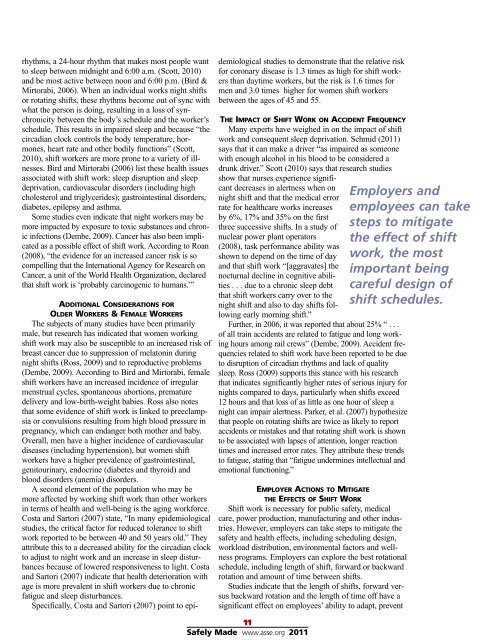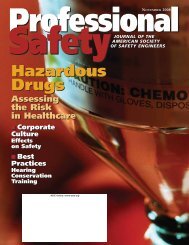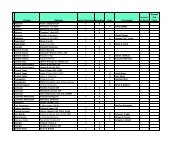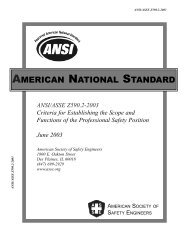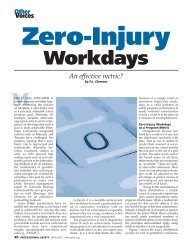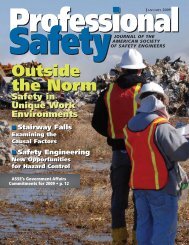Safety & Health Effects of Shift Work - ASSE Members
Safety & Health Effects of Shift Work - ASSE Members
Safety & Health Effects of Shift Work - ASSE Members
You also want an ePaper? Increase the reach of your titles
YUMPU automatically turns print PDFs into web optimized ePapers that Google loves.
hythms, a 24-hour rhythm that makes most people want<br />
to sleep between midnight and 6:00 a.m. (Scott, 2010)<br />
and be most active between noon and 6:00 p.m. (Bird &<br />
Mirtorabi, 2006). When an individual works night shifts<br />
or rotating shifts, these rhythms become out <strong>of</strong> sync with<br />
what the person is doing, resulting in a loss <strong>of</strong> synchronicity<br />
between the body’s schedule and the worker’s<br />
schedule. This results in impaired sleep and because “the<br />
circadian clock controls the body temperature, hormones,<br />
heart rate and other bodily functions” (Scott,<br />
2010), shift workers are more prone to a variety <strong>of</strong> illnesses.<br />
Bird and Mirtorabi (2006) list these health issues<br />
associated with shift work: sleep disruption and sleep<br />
deprivation, cardiovascular disorders (including high<br />
cholesterol and triglycerides); gastrointestinal disorders,<br />
diabetes, epilepsy and asthma.<br />
Some studies even indicate that night workers may be<br />
more impacted by exposure to toxic substances and chronic<br />
infections (Dembe, 2009). Cancer has also been implicated<br />
as a possible effect <strong>of</strong> shift work. According to Roan<br />
(2008), “the evidence for an increased cancer risk is so<br />
compelling that the International Agency for Research on<br />
Cancer, a unit <strong>of</strong> the World <strong>Health</strong> Organization, declared<br />
that shift work is ‘probably carcinogenic to humans.’”<br />
ADDITIONAL CONSIDERATIONS FOR<br />
OLDER WORKERS & FEMALE WORKERS<br />
The subjects <strong>of</strong> many studies have been primarily<br />
male, but research has indicated that women working<br />
shift work may also be susceptible to an increased risk <strong>of</strong><br />
breast cancer due to suppression <strong>of</strong> melatonin during<br />
night shifts (Ross, 2009) and to reproductive problems<br />
(Dembe, 2009). According to Bird and Mirtorabi, female<br />
shift workers have an increased incidence <strong>of</strong> irregular<br />
menstrual cycles, spontaneous abortions, premature<br />
delivery and low-birth-weight babies. Ross also notes<br />
that some evidence <strong>of</strong> shift work is linked to preeclampsia<br />
or convulsions resulting from high blood pressure in<br />
pregnancy, which can endanger both mother and baby.<br />
Overall, men have a higher incidence <strong>of</strong> cardiovascular<br />
diseases (including hypertension), but women shift<br />
workers have a higher prevalence <strong>of</strong> gastrointestinal,<br />
genitourinary, endocrine (diabetes and thyroid) and<br />
blood disorders (anemia) disorders.<br />
A second element <strong>of</strong> the population who may be<br />
more affected by working shift work than other workers<br />
in terms <strong>of</strong> health and well-being is the aging workforce.<br />
Costa and Sartori (2007) state, “In many epidemiological<br />
studies, the critical factor for reduced tolerance to shift<br />
work reported to be between 40 and 50 years old.” They<br />
attribute this to a decreased ability for the circadian clock<br />
to adjust to night work and an increase in sleep disturbances<br />
because <strong>of</strong> lowered responsiveness to light. Costa<br />
and Sartori (2007) indicate that health deterioration with<br />
age is more prevalent in shift workers due to chronic<br />
fatigue and sleep disturbances.<br />
Specifically, Costa and Sartori (2007) point to epidemiological<br />
studies to demonstrate that the relative risk<br />
for coronary disease is 1.3 times as high for shift workers<br />
than daytime workers, but the risk is 1.6 times for<br />
men and 3.0 times higher for women shift workers<br />
between the ages <strong>of</strong> 45 and 55.<br />
THE IMPACT OF SHIFT WORK ON ACCIDENT FREQUENCY<br />
Many experts have weighed in on the impact <strong>of</strong> shift<br />
work and consequent sleep deprivation. Schmid (2011)<br />
says that it can make a driver “as impaired as someone<br />
with enough alcohol in his blood to be considered a<br />
drunk driver.” Scott (2010) says that research studies<br />
show that nurses experience significant<br />
decreases in alertness when on<br />
night shift and that the medical error<br />
rate for healthcare works increases<br />
by 6%, 17% and 35% on the first<br />
three successive shifts. In a study <strong>of</strong><br />
nuclear power plant operators<br />
(2008), task performance ability was<br />
shown to depend on the time <strong>of</strong> day<br />
and that shift work “[aggravates] the<br />
nocturnal decline in cognitive abilities<br />
. . . due to a chronic sleep debt<br />
that shift workers carry over to the<br />
night shift and also to day shifts following<br />
early morning shift.”<br />
Further, in 2006, it was reported that about 25% “ . . .<br />
<strong>of</strong> all train accidents are related to fatigue and long working<br />
hours among rail crews” (Dembe, 2009). Accident frequencies<br />
related to shift work have been reported to be due<br />
to disruption <strong>of</strong> circadian rhythms and lack <strong>of</strong> quality<br />
sleep. Ross (2009) supports this stance with his research<br />
that indicates significantly higher rates <strong>of</strong> serious injury for<br />
nights compared to days, particularly when shifts exceed<br />
12 hours and that loss <strong>of</strong> as little as one hour <strong>of</strong> sleep a<br />
night can impair alertness. Parker, et al. (2007) hypothesize<br />
that people on rotating shifts are twice as likely to report<br />
accidents or mistakes and that rotating shift work is shown<br />
to be associated with lapses <strong>of</strong> attention, longer reaction<br />
times and increased error rates. They attribute these trends<br />
to fatigue, stating that “fatigue undermines intellectual and<br />
emotional functioning.”<br />
EMPLOYER ACTIONS TO MITIGATE<br />
THE EFFECTS OF SHIFT WORK<br />
<strong>Shift</strong> work is necessary for public safety, medical<br />
care, power production, manufacturing and other industries.<br />
However, employers can take steps to mitigate the<br />
safety and health effects, including scheduling design,<br />
workload distribution, environmental factors and wellness<br />
programs. Employers can explore the best rotational<br />
schedule, including length <strong>of</strong> shift, forward or backward<br />
rotation and amount <strong>of</strong> time between shifts.<br />
Studies indicate that the length <strong>of</strong> shifts, forward versus<br />
backward rotation and the length <strong>of</strong> time <strong>of</strong>f have a<br />
significant effect on employees’ ability to adapt, prevent<br />
Employers and<br />
employees can take<br />
steps to mitigate<br />
the effect <strong>of</strong> shift<br />
work, the most<br />
important being<br />
careful design <strong>of</strong><br />
shift schedules.<br />
11<br />
Safely Made www.asse.org 2011


